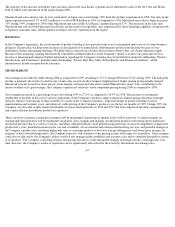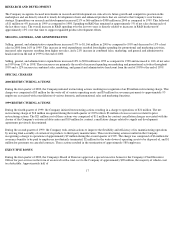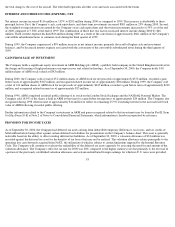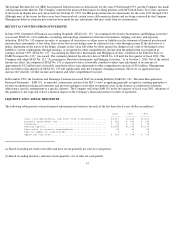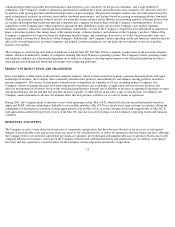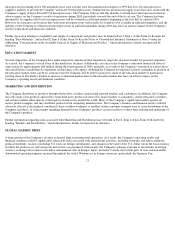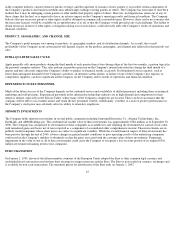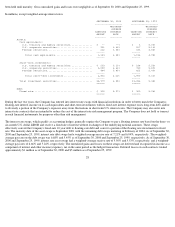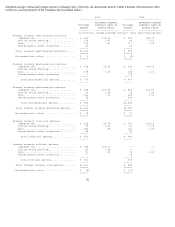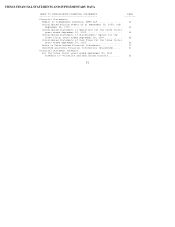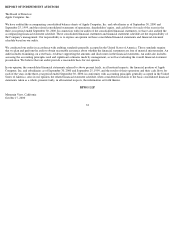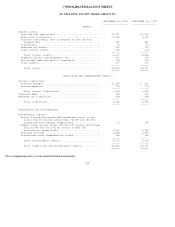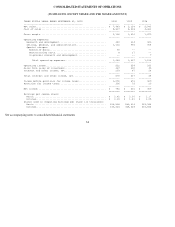Apple 2000 Annual Report Download - page 28
Download and view the complete annual report
Please find page 28 of the 2000 Apple annual report below. You can navigate through the pages in the report by either clicking on the pages listed below, or by using the keyword search tool below to find specific information within the annual report.in the computer industry, current extensive patent coverage, and the rapid rate of issuance of new patents, it is possible certain components of
the Company's products and business methods may unknowingly infringe existing patents of others. The Company has from time to time been
notified that it may be infringing certain patents or other intellectual property rights of others. However, no litigation has arisen out of any of
these claims that has had, or is expected to have, an adverse impact on the Company's operating results and financial condition. The Company
believes that any necessary patent or other rights could be obtained on commercially reasonable terms. However, there can be no assurance that
the necessary licenses would be available on acceptable terms, if at all, or that the Company would prevail in any such challenge. The failure to
obtain necessary licenses or other rights, or litigation arising out of such claims, could adversely affect the Company's results of operations and
financial condition.
PRODUCT, GEOGRAPHIC, AND CHANNEL MIX
The Company's profit margins vary among its products, its geographic markets, and its distribution channels. As a result, the overall
profitability of the Company in any given period will depend, in part, on the product, geographic, and channel mix reflected in that period's net
sales.
INTRA-QUARTER SALES CYCLE
Apple generally sells more products during the third month of each quarter than it does during either of the first two months, a pattern typical in
the personal computer industry. This sales pattern can produce pressure on the Company's internal infrastructure during the third month of a
quarter and may adversely impact the Company's ability to predict its financial results accurately. Developments late in a quarter, such as
lower-than-anticipated demand for the Company's products, an internal systems failure, or failure of one of the Company's key logistics or
components suppliers, can have significant adverse impacts on the Company and its results of operations and financial condition.
DEPENDENCE ON KEY PERSONNEL
Much of the future success of the Company depends on the continued service and availability of skilled personnel, including those in technical,
marketing and staff positions. Experienced personnel in the information technology industry are in high demand and competition for their
talents is intense, especially in the Silicon Valley, where many of the Company's employees are located. There can be no assurance that the
company will be able to successfully attract and retain the key personnel it needs. Additionally, volatility or a lack of positive performance in
the Company's stock price may adversely affect its ability to retain key employees.
MINORITY INVESTMENTS
The Company holds minority investments in several public companies including Samsung Electronics Co., Akamai Technologies, Inc.,
EarthLink, and ARM Holdings plc. The combined fair market value of these investments was approximately $786 million as of September 30,
2000. The Company has categorized its investments in these companies as available-for-sale requiring the investments be carried at fair value,
with unrealized gains and losses net of taxes reported as a component of accumulated other comprehensive income. These investments are in
publicly traded companies whose share prices are subject to significant volatility. While the overall financial impact of these investments has
been positive through the end of 2000, adverse changes in general market conditions or poor operating results of the underlying companies
could result in the Company's inability to ultimately realize the gains associated with the carrying value of these investments. Permanent
impairment in the value of one or all of these investments could cause the Company to recognize a loss on some portion of its original $316
million investment remaining in these four companies.
EURO TRANSITION
On January 1, 1999, eleven of the fifteen member countries of the European Union adopted the Euro as their common legal currency and
established fixed conversion rates between their existing sovereign currencies and the Euro. The Euro is now traded on currency exchanges and
is available for non-cash transactions. The transition period for introduction of the Euro ends on January 1, 2002.
25



